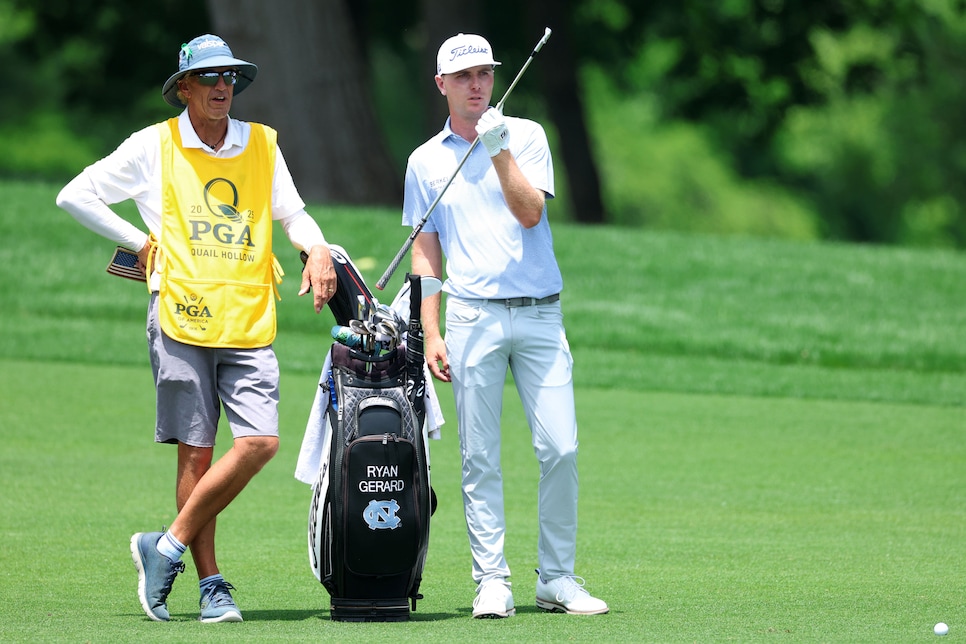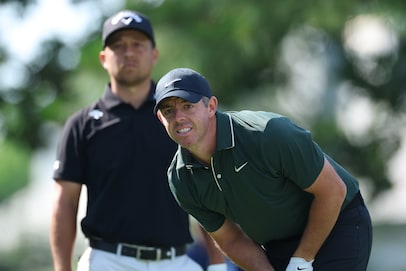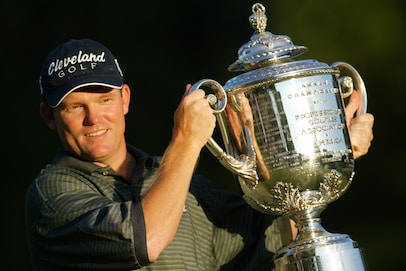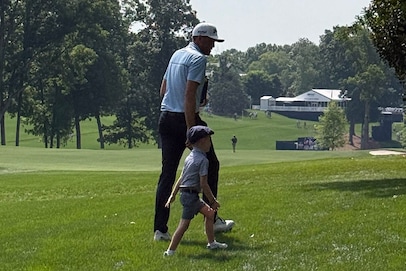CHARLOTTE — You stare at the leaderboard in disbelief. Don’t. You’ve fallen victim to the fiction orchestrated by golf’s crooked media—fake news, as our modern parlance would have it. Thursday’s revelations at Quail Hollow weren’t anomalies but rather confirmations of an established pattern: Contrary to some of the things you’ve heard, this course has an uncanny talent for ushering Cinderella stories into the dance.
A peculiar consensus had crystallized before this 2025 PGA Championship, that within its expansive field of 156 only a handful merited consideration. Rory McIlroy was an understood co-favorite, what with four career triumphs at Quail Hollow, three victories this season alone and finally unburdened from the weight of expectation that had become his shadow. Alongside him in the betting markets loomed Scottie Scheffler, holder of three consecutive Player of the Year trophies and fresh from equaling a tour scoring record in his previous start. Bryson DeChambeau, unquestionably among the world’s elite triumvirate over the past year, arrived with momentum from a recent LIV conquest to a course seemingly architected for his length. The Wanamaker’s current custodian, Xander Schauffele, boasted two runner-up finishes in his last Quail outings, while Justin Thomas—who conquered this property in 2017—had rediscovered form reminiscent of his prime. Jon Rahm, Ludvig Aberg, and Collin Morikawa warranted peripheral discussion, but beyond this select few, conventional wisdom suggested the conversation need not continue.
Now, performance rarely aligns with expectation in golf, especially given the game’s current depth of talent. Yet anticipating a showcase from the stars in Charlotte seemed entirely justified. In its set-up and character, Quail Hollow presents as singularly dimensional—a sentiment echoed throughout the week as player after player confided that their only viable strategy off the tee was to unleash driver with maximum force, which hardly constitutes strategy at all. This tournament would reward raw power, and the game’s preeminent figures possess this attribute over their colleagues. More broadly, major championships have, for a significant stretch, become the exclusive domain of established names. The era of Y.E. Yang and Ben Curtis has receded into distant memory. Over the past 13 years, merely two players ranked outside the world’s top 40 have hoisted major trophies—one being Phil Mickelson’s age-defying conquest at Kiawah’s Ocean Course.
Yet as Thursday’s morning wave concluded their first rounds, the leaderboard was a counter to this belief. Instead, it was populated almost exclusively by figures removed from golf’s upper echelon, led by Ryan Gerard, a 25-year-old North Carolina grad in his second full year on tour and playing in just his third major but out front by one stroke after an opening-round 66.

David Cannon
Also among them sits Luke Donald with a four-under 67. He once reigned as World No. 1, but entered this week at 871st. You know who’s 870th in the world? Of course you don’t, because that would be a silly thing to know (although we assume it’s someone on the Scandinavian mini-tours). Donald has mustered precisely one top-10 finish on the PGA Tour in nearly a decade, this marking just his fifth major appearance in nine years. The last time he infiltrated the top 10 during any major championship round? A distant 2015. His presence here exists solely because the PGA of America maintains a tradition of extending courtesy invitations to Ryder Cup captains.
Stephen Jaeger (67), while demonstrating respectable form this season (28th in strokes gained, 33rd in FedEx Cup standings), remains a 35-year-old journeyman with one tour victory decorating his résumé—oddsmakers dismissively installed him at astronomical 175-to-1 odds. Ryo Hisatsune (68) barely has his tour card warm, competing in just his second year on the circuit. Alex Smalley (67) wasn’t even confirmed for this championship until Sahith Theegala’s 11th-hour withdrawal on Wednesday. Alex Noren (68) saw his body betray him with devastating hamstring and glute tears in January; last week’s tournament in Philadelphia was his first event in half a year. Ryan Fox (67), though victorious in his last outing, claimed that trophy in a field-depleted alternate event, and had to have that win just to get into this week’s championship.
While the initial reaction might be bewilderment, perhaps the more illuminating question is: Why did anyone expect differently? Critics might assert that golf was statistically overdue for a longshot being in the mix. However, this unexpected storyline is precisely Quail Hollow’s signature. Yes, the course boasts an illustrious roster of champions including Rory, JT, and Tiger Woods, yet more than any consequential venue on the PGA Tour circuit, it has consistently birthed winners from competitive obscurity.
These grounds have catalyzed career-defining breakthroughs for Wyndham Clark, Max Homa, and Anthony Kim. Consider Derek Ernst in 2013—entering as a fourth alternate, languishing beyond the 1,000th position in world rankings before winning his lone tour victory. J.B. Holmes resurrected his dormant career here in 2014, claiming his first trophy in six years; Joey Sindelar ended a 14-year victory drought on these same fairways.
The explanation lies in Quail’s architectural profile—its conspicuous lack of subtlety or strategy. While length certainly advantages players, the fairways stretch invitingly wide and, despite this week’s torrential precipitation, the rough remains mysteriously benign. The championship has devolved into essentially a short-game exhibition: Donald surrendered strokes to the field off the tee and struck a paltry nine greens in regulation, yet gained five strokes with his putter alone.
As Brooks Koepka once astutely observed, most majors naturally winnow the field to 30 or so legitimate contenders through the dual crucibles of course complexity and psychological pressure. While that pressure indisputably persists, without the course mounting meaningful resistance, errors become purely self-inflicted wounds rather than extracted penalties. This doesn’t guarantee a longshot will hoist the Wanamaker Trophy come Sunday, nor does it relegate the game’s best to irrelevance. Rather, for the first time in recent major championship memory, an underdog possesses a legitimate path to glory. And we should have seen it coming.
More on the PGA Championship  That’s Golf PGA Championship 2025: Super group of Scottie Scheffler, Rory McIlroy and Xander Schauffele all eject on SAME hole
That’s Golf PGA Championship 2025: Super group of Scottie Scheffler, Rory McIlroy and Xander Schauffele all eject on SAME hole  PGA Championship PGA Championship 2025: Where have all the Cinderella major winners gone?
PGA Championship PGA Championship 2025: Where have all the Cinderella major winners gone?  Awwdorable PGA Championship 2025: Keegan Bradley’s son adorably interrupts dad’s first round at Quail Hollow for a hug MORE GOLF DIGEST PGA CHAMPIONSHIP COVERAGE
Awwdorable PGA Championship 2025: Keegan Bradley’s son adorably interrupts dad’s first round at Quail Hollow for a hug MORE GOLF DIGEST PGA CHAMPIONSHIP COVERAGE
PGA Championship 101: Answering all your frequently asked questions
How to watch the 2025 PGA Championship
Power Rankings: Every player in the PGA field, ranked
The 13 best bets to win at Quail Hollow
Tee times for the first and second round
Crunching the numbers: Why Rory McIlroy is so good at Quail Hollow
Quail Hollow’s three-hole stretch that could decide the PGA Championship
PGA Championship: Better in May or August?
Where have all the Cinderella major champions gone?
The things that still shock us from Scottie Scheffler’s bizarre arrest at the 2024 PGA
The most ‘PGA’ moments in PGA Championship history
This article was originally published on golfdigest.com

